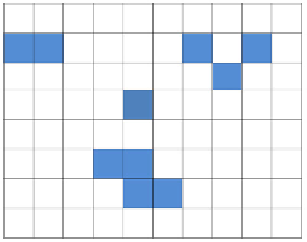Biology Reference
In-Depth Information
various actions. Students can learn the language and environment through exploration
of the NetLogo library models, but there is also an excellent text by Grimm and
Railsback that thoroughly walks a new ABM explorer through model development
and the NetLogo platform [
7
].
Exercise 4.7.
Google “NetLogo” to find its Northwestern University homepage,
and download the free software onto your computer.
4.1.3
A Brief History of Agent-Based Modeling
Although ABMs became widely popular for computation in the 1990s, their first
instantiations were modest. In the 1940s, Von Neumann created a simple grid on
paper to emulate a machine whose sole purpose was to copy itself [
8
]. Each cell in
this grid has a state, “on” or “off” (see Figure
4.3
). The cell's neighborhood is defined
with respect to each individual cell, e.g., any cell less than two cells away. With each
time step, a newgeneration of each cell's state is defined using a function of the current
state of the cell and the states of the cell's neighbors. Thus, the cell's current state
influences and is influenced by its neighbors' states. Global patterns can be found
based on the function used to create each new generation of cells. This process is now
known as cellular automata.
The next innovation in ABMs is from Conway and his Game of Life [
9
]. Despite
its grand moniker, the Game of Life is a simple zero player game, meaning that its
only human input is in its initialization. A grid of Von Neumann's cells is encoded
with some very basic rules concerning the state of the cell, i.e., “live” or “dead”,
and the generation function, which, as above, changes the state based on the current
state and the state of its neighbors. Despite its simplicity, the Game of Life perfectly
demonstrates emergent behavior: patterns and self-organization evolve from simula-
tions of various initial conditions.
Another early pioneer in the development of agent-based modeling is Thomas
Schelling, who in 1978 published what is now known as Schelling's Tipping Model.
The model highlighted the process of observing large-scale societal ramifications for
FIGURE 4.3
An illustration of a basic cellular automata grid.






Search WWH ::

Custom Search